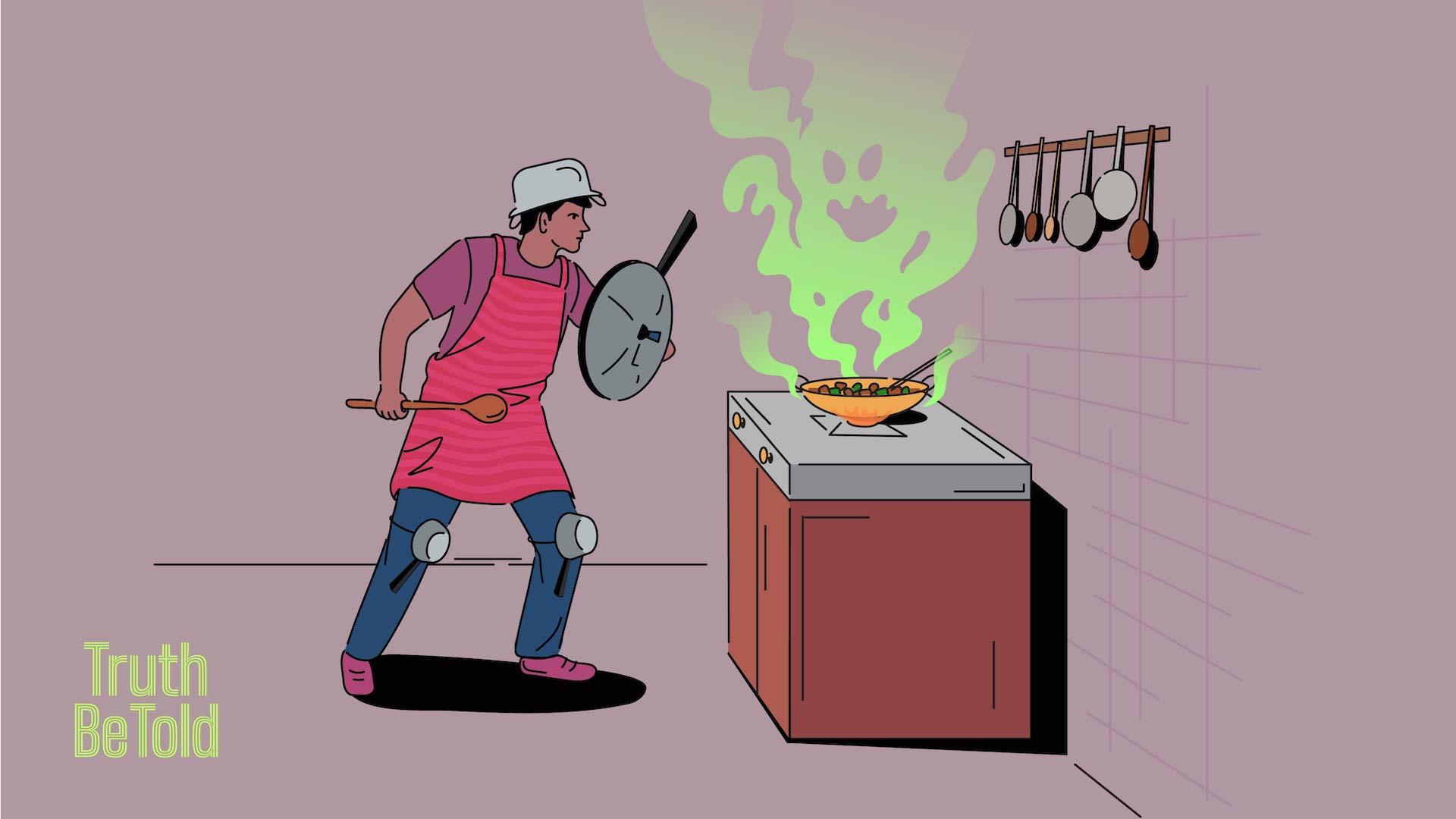Safest cooking utensils for healthy living
Five science backed tips for your kitchen
The most trustworthy source of food and
fitness journalism in the country.
The healthy lifestyle talk mostly revolves around diet, exercise, and sleep. Food matters, but what you prepare and cook your food in also matters.
The type of cookware you choose boils down to two things:
One, reactivity to food: you don’t want your utensil to react undesirably with the food you’re cooking.
Two, heat conduction: you want the heat to be evenly distributed so that food is neither under nor overcooked.
Here are five science-backed tips to get your kitchenware right.
1) Earthen cookware minus contaminants = great buy
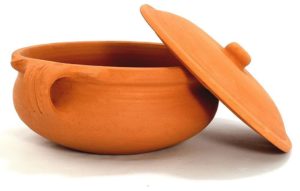
Traditional earthen cookware
Earthen pots are made of clay and permanently hardened by heat. They’re eco-friendly and are making a comeback.
There are two types of ceramic cookware available in the market: glazed and unglazed.
Unglazed: They are porous, meaning the material used to make the clay will likely leach out during cooking. This is great if minerals beneficial for our body leach out (like calcium or magnesium) but terrible if the material contains heavy metals (like lead, cadmium, or arsenic).
What to do? Buy from companies that test clay quality before manufacturing cookware. So, choose companies that have high-quality standards or those that publish their test results.
Glazed: Glazing pottery means coating it with a sealant layer to overcome its porosity. This sealant could be ash, tin, porcelain, or salt. What you don’t want: lead. Manufacturers use it for giving ceramics a glossy metallic — looks cool. But screw that: it’s not good for us because even in small doses, lead is poisonous. Most sellers avoid lead glazing but do check to be sure.
Takeaway: Ceramics are a great buy for those looking to buy eco-friendly cookware. Ensure that the makers have tested the raw materials for heavy metal contaminants.
2) Metal cookware is durable, but it should not react with food
The one downside of earthen cookware is that it breaks easily. On the other hand, metal-based cookware — made of copper, aluminium, iron, or stainless steel — is sturdy. In addition, they are good heat conductors, meaning they heat fast and evenly, so the food cooks well in lesser time.
Remember these four points when buying metal cookware:
One: Copper cookware should be lined with tin
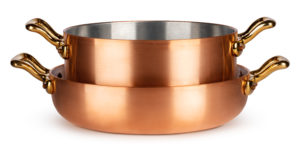
A lined copper vessel
Copper accumulation in the body can lead to copper poisoning over time. This is why copper cookware is sold as alloys (brass, bronze), often with tin coating. The tin coating prevents the metal from leaching. Tin does not react with acids, and our bodies don’t absorb tin.
Even on accidental consumption, tin just exits the body in the faeces. So, always buy copper cookware that has been lined with tin. Over several years of usage, the tin coating may wear off, so you have to get the vessel re-tinned.
Two: Anodised aluminium cookware minus coating is better

This metal isn’t as expensive as copper and thus more prevalent in homes. Is consumption of aluminium harmful if leached out? There aren’t any immediate harmful effects, but long-term exposure to aluminium has been associated with Alzheimer’s disease.
Manufacturers circumvent this problem by coating aluminium cookware with either a PTFE (Polytetrafluoroethylene, commonly called Teflon) non-stick or a ceramic layer. In this so-called “ceramic coating,” manufacturers use a synthetic material called sol-gel, which gives a ceramic-like finish. Unfortunately, this style has a limited shelf life of fewer than two years because the coating starts to peel off over time.
So, what’s the solution? Get hard anodised aluminium cookware (without the additional coating). Anodisation is a process of highly controlled oxidation. The aluminium oxide, which is formed on the outside, protects the inner pure-aluminium layer from getting exposed to the food. This anodised layer makes the vessel resistant to corrosion. The finished anodised surface will not chip or peel. Over several years, the outer oxide layer may get worn down to expose the inner aluminium layer. If that happens, avoid using the vessel to make acidic foods as it may cause the aluminium to leach.
Like what you see so far?
Get TBT articles in your inbox every Saturday
Third: Iron utensils are safe but can give a metallic tang to food
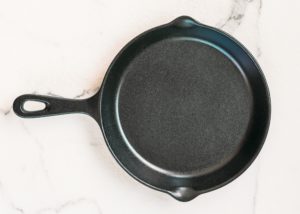
A cast iron pan
Iron also reacts with acids. But iron consumption via cookware rarely leads to iron overdose in the body.
Most Indians could use more iron in their diet. The one drawback of iron cookware is that it adds a metallic tang to foods cooked or stored in it.
So, high-end cast iron manufacturers coat cast iron cookware with glazed enamel to avoid any food reactions. But glazed enamel is extremely expensive. Example: Le Creuset. However, a simpler and cheaper solution is to transfer the foods to another non-reactive vessel immediately after cooking.
Four: Stainless Steel is the most popular for a reason

Stainless steel utensils
Iron gives us stainless steel when alloyed with chromium (and other elements such as carbon and nickel). High-quality stainless steel pans contain 18-20% chromium. The presence of chromium prevents the iron from rusting.
Stainless steel is highly resistant to corrosion and acid, making it one of the most well-deserved popular cookware.
Takeaway: Metal-based cookware tends to react with acids. Iron is a reasonably safe metal, even if it gets leached out. For all other metals, ensure either a non-reactive coating on top (like tin) or that the metal is converted into a less reactive alloy (stainless steel or anodised aluminium).
3) Nonstick coatings can be harmful
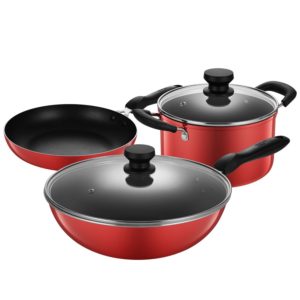
Anyone who’s made an omelette knows that eggs tend to stick to the pan. Why? Well, the protein in the egg starts forming chemical bonds with the metal pan, making it cling to the pan’s surface.
The solution to this problem is Polytetrafluoroethylene (PTFE). PTFE is a coating used to lend a non-stick surface to cookware. It’s commonly known as Teflon, which is a brand name.
Teflon hates everything. It hates water, it hates starches, it hates proteins. It only likes itself and bonds to itself. Plus, it is incredibly non-reactive to acids. Teflon’s original purpose was to help store one of the world’s most corrosive acids used to develop the atomic bomb. This is why this man-made polymer is such a popular cooking medium.
Teflon coating starts to chip over time. You could accidentally swallow flakes, but your body excretes them since it doesn’t react with any acid (not even the acid in your stomach). So, the drawback of Teflon isn’t ingestion but having to replace the pan to ensure it serves its purpose.
But the biggest drawback of using non-stick cookware is that the fumes they emit at high temperatures are toxic. Most Indian food cooks between 170-180 C while deep frying occurs at 200 C. Non-stick pans emit toxic fumes when the pan’s temperature reaches 280 C. According to the Good Housekeeping Institute which tested the pan temperatures, a cheap lightweight pan can reach 260 C in less than two minutes if it is empty, and a heavyweight pan with a burger reaches 300 C in 8.5 minutes. These fumes have been documented to kill pet birds and inhaling these fumes can create flu-like symptoms due to polymer fume fever. To remain safe, don’t leave your non-stick pan on the gas unattended.
The last problem with non-stick is that it prevents you from becoming a better cook. Have you ever seen chefs relying on non-stick? Most likely not. Learning to season a cast iron or your clay pot takes skill and practice. So is learning to use the right amount of fat to prevent food from sticking to the bottom while providing flavour. Rather than depending on a chemical’s potentially harmful properties, using traditional cookware tools to your advantage will help your cooking skills in the long run.
I don’t recommend Teflon cookware. It’s a complex chemical, and scientists are still trying to understand its effects on our bodies and the planet. (You may watch the Netflix movie Dark Waters to know more.)
But if you already own non-stick cookware, use it correctly. Don’t leave the pan unattended when cooking to avoid overheating.
Takeaway: Non-stick cookware is an easy solution for the short term. But to avoid any chance of harm and become a better cook, it is best to switch to other cookware in the long term.
4) The price of a knife is not as crucial as its sharpness
A sharp, durable, and sturdy knife is essential when preparing a meal. A good knife should be safe and efficient. Efficiency because you need to apply less pressure, which leads to faster chopping. And safety because a dull knife is dangerous: it requires more pressure to cut, increasing the chances of the knife slipping when force is applied, potentially leading to cuts and injuries.
Knives have three parts: the handle, tang and blade. The quality and materials used lead to price variations. Here’s what you need to know to choose the best knife for your kitchen:
1. The handle can be made of wood, metal, synthetic or composite material. Wood handles are the most expensive. They look beautiful but are high maintenance. You need to wash them by hand and oil them after use—best for knife connoisseurs. Metal handles look clean and pleasing but feel slippery and uncomfortable. Synthetic materials are what you see in cheaper, everyday knives. These are easy to clean, come in different colours and are highly durable.
2. The tang is a piece of blade that extends down the middle of the handle. If the tang extends to the back of the handle, it is called a full tang knife. A full tang knife generally indicates higher quality because the more the tang extends back, the heavier it feels in hand. This counterbalances the heavy blade, and the weight feels more well spread.
3. The blade. There are two categories of steel blade knives: stainless steel and high-carbon steel. Home cooks use stainless steel knives; professional chefs prefer high-carbon steel knives. Stainless steel knives do not rust and are an excellent choice for everyday cooks. High-carbon steel knives are superior, but they rust easily unless cared for, and the blades are brittle and can chip easily.
There are also ceramic knives in the market. They’re very sharp, but once they lose their sharpness, you have to get them sharpened by a diamond sharpening stone. This is impractical for most of us.
Takeaway: Buy a knife that feels comfortable to you. Maintain its sharpness either by using a knife sharpener at home or getting it sharpened by a professional whenever it feels dull. A cheap knife sharpened recently is 100x better than an expensive, old, unsharpened knife.
5) Wooden cutting boards are still the best
Cutting boards can be made of wood, plastic, stainless steel, marble, glass or silicone.
When choosing which one to buy, you need to consider two things: Is it easy to clean? Does it prevent bacterial growth?
Wooden cutting boards are hygienic. Wood traps bacteria in the pores along with water. The water evaporates, drying out and killing the bacteria. The drawback? These boards must be washed by hand and cannot withstand a dishwasher.
Plastic boards are hardier. They can withstand dishwashers and don’t need any special care. But wet plastic boards provide a friendly environment for the bacteria to multiply. Over time, plastic boards get scratched, giving bacteria more space to breed. Also, handwashing a plastic board does not guarantee that it’ll be rid of bacteria.
Glass, marble and stainless steel cutting boards have tough surfaces, leading to faster dulling of knives — plastic and wood win here. Plus, these boards are noisier.
Silicone cutting boards are soft on knife edges and do not harbour bacteria. Moreover, they can be sterilised in the dishwasher since silicone can withstand a wide range of temperatures. The problem with silicon boards is that they show knife dents soon and retain smells and stains easily. It’s also difficult to lift them off the counter.
Takeaway: Wood is thus the best material for a cutting board. Just make sure to hand wash and dry after each use and these will last a long time in your kitchen.
Conclusion
Health starts in the kitchen, and I hope these tips help you choose the best cookware for your home. How you prepare your food — the oils you use or the utensils you choose — all add incremental value to your lifestyle. You don’t always need expensive stuff, just what works best for you.
Click the logo to sign up for the newsletter
More from Truth Be Told
Beware: New Year marketing is here!
Everyone has an opinion on your body. But why?
Your brain needs to relax and here’s how you can do it
Here’s how I got my cholesterol levels down
Why you can’t eat just one chip
The Definitive Guide to Smart Food Shopping
I solved the mystery of the afternoon slump with CGM
Eight swaps to eat better everyday
Diwali indulgence won’t make you fat
What spikes your blood glucose?
Is your body ageing gracefully?
Should you count calories?
Letters to Editor: Reader Response 01
My experiments with sleep
8 tips to choose the right cooking oil
You can’t be ‘healthy’, if you don’t know what it means
Food and fitness journalism is broken. We are fixing it.
